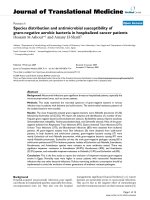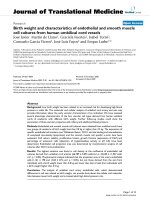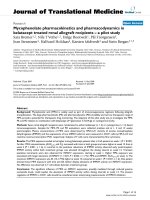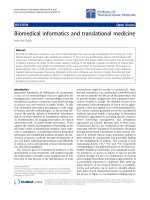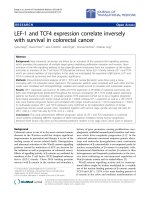Báo cáo hóa học: " New materials and devices for preventing catheter-related infections" pdf
Bạn đang xem bản rút gọn của tài liệu. Xem và tải ngay bản đầy đủ của tài liệu tại đây (248.95 KB, 9 trang )
REVIE W Open Access
New materials and devices for preventing
catheter-related infections
Jean-François Timsit
1,2*
, Yohann Dubois
1
, Clémence Minet
1
, Agnès Bonadona
1
, Maxime Lugosi
1
,
Claire Ara-Somohano
1
, Rebecca Hamidfar-Roy
1
and Carole Schwebel
1
Abstract
Catheters are the leading source of bloodstream infections for patients in the intensive care unit (ICU).
Comprehensive unit-based programs have proven to be effective in decreasing catheter-related bloodstream
infections (CR-BSIs). ICU rates of CR-BSI higher than 2 per 1,000 catheter-days are no longer acceptable. The locally
adapted list of preventive measures should include skin antisepsis with an alcoholic preparation, maximal barrier
precautions, a strict catheter maintenance policy, and removal of unnecessary catheters. The development of new
technologies capable of further decreasing the now low CR-BSI rate is a major challenge. Recently, new materials
that decrease the risk of skin-to-vein bacterial migration, such as new antiseptic dressings, were extensively tested.
Antimicrobial-coated catheters can prevent CR-BSI but have a theoretical risk of selecting resistant bacteria. An
antimicrobial or antiseptic lock may prevent bacterial migration from the hub to the bloodstream. This review
discusses the available knowledge about these new technologies.
Introduction
Central venous catheters (CVCs) are inserted in
approximately half of all patients in the intensive care
unit (ICU). In Europe, the incidence density of catheter-
related bloodstream infections (CR-BSI) ranges from 1
to 3.1 per 1,000 patient-days [1]. CR-BSIs were asso-
ciated with an attributable mortality of 0% to 11.5% [2]
and an additional stay length of 9-12 days [3,4].
In contrast to other nosocomial infections, CR-BSI has
many device-related risk factors. Consequently, preven-
tion should be possible, provided that rigorous policies
are implemented. Specific education and training of
healthcare workers in CR-BSI prevention and continu-
ous implementation of u nit-based quality-improvement
programs are essential. We discuss the potential useful-
ness of new technical developments and put these into
perspective according to available recommendations.
Mechanisms of infection
Colonization of the catheter occurs via two main path-
ways: the extraluminal route and the intraluminal route.
Colonization of short-term CVCs (< 15-20 days) occurs
predominantly from the skin puncture site, whereas
colonization of long-term CVCs is usually related to
intraluminal bacterial spread from a contaminated hub
[5]. In both cases, the source of the micro-organisms is
the patient’s own commensal skin flora. Accordingly, S.
epidermidis is responsible for 40-50% of episodes, fol-
lowed by S. aureus (10-20%). Gram-negative blood-
stream infection, especially Pseudomonas aeruginosa,
Stenotrophomonas sp., and Acinetobacter baumannii, are
recovered in one-third of cases. Candida sp. are recov-
ered in 3-10% of cases.
Biofilm formation on the inner and outer surfaces of
the catheter contributes to the development of CR-BSI.
A biofilm is a complex structure formed by bacteria that
have attached to an artificial surface or dead tissue. Bac-
terial attachment to the catheter surface begins within
24 hours after catheter insertion. The bacteria prolifer-
ate and secrete a polysaccharide matrix, which provides
a medium for the attachment of additional organisms.
Constitution of a biofilm is virtually inevitable but does
not necessarily lead to clinical manifestations of infec-
tion, probably because the bacteria contained in the bio-
film are characterized by slow growth and limited
virulence [6]. Clinical biofilm infection is typically resis-
tant to antimicrobials, not only because the antimicro-
bials cannot penetrate into all the biofilm layers, but
* Correspondence:
1
Medical Polyvalent Intensive Care Unit, University Joseph Fourier, Albert
Michallon Hospital, BP 217, 38043 Grenoble Cedex 9, France
Full list of author information is available at the end of the article
Timsit et al. Annals of Intensive Care 2011, 1:34
/>© 2011 Timsit et al; licensee Springer. This is an Open Access article distributed u nder the terms of the Creative Commons Attribution
License ( w hich permits unrestricted use, distribution, and reproduction in any medium,
provided the original work is properly cited.
also because the organisms grow slowly and may be
resistant to immune defence mechanisms.
The pathogenesis of fibrin sheath formation from the
biofilm is poorly understood. According to the best
available evidence, biofilm formation is the first event.
Subsequently, f ibrin and many other molecules, such as
laminin, collagen, and even muscle cells, convert the
film to a mature sheath [7]. Metallic cations, such as
magnesium, calcium, and iron, may stabilize the biofilm
and contribute both to its development and bacterial
growth [8]. Catheter thrombosis on the fibrin sheath
may be facilitated by platelet activat ion, decreased levels
of protein C and antithrombin III, hyperfibrinogenemia,
and homocysteine elevation. Clinical evidence suggests
that the risk of thrombosis may increase with the sever-
ity of the infection, the occurrence of bacteremia, and
CR-BSI [9-11].
Diagnosis of catheter infections
The diagnostic methods that are currently accepted
worldwide must be borne in mind, because differences in
the methods used clearly introduced bias in trials on pre-
ventive strategies. In current French recommendations
for patients with BSI, a positive quantitative [12,13] or
semiquantitative [14] catheter culture is needed to deter-
mine that the catheter caused the BSI. Alt ernatively,
simultaneous comparative quantitative blood samples
[15]orthedifferenceintime to positivity of blood from
the hub and peripheral blood [16] should be determined.
However, the Centers for Disease Control definition of
central-line associated bloodstream infection (CLABSI)
[17], which does not take catheter culture results into
account, often is used as an acceptable surrogate. This
definition requires a single blood culture positive for a
pathogen (or two cultures positive for a common com-
mensal) not recovered from any nonblood cultures dur-
ing the 3 days preceding and 7 days following. This
definition is insufficiently accurate [18,19]. Considerable
variability occurs among experts [20,21] and hospitals
[18] in the classification of infections as CLABSI or sec-
ondary bacteremia. In addition, this definition is
obviously dependent of the number of blood cultures
performed before introducing new antimicrobials and the
number of nonblood cultures performed to look for an
infectious focus responsible for secondary BSI.
Prevention
A number of published studies have investigated various
measures for decreasing the CR-BSI rate [22]. Some of
them evaluated multimodal programs to improve gen-
eral infection control measures when using catheters,
such as surveillance, education, and quality management
strategies, whereas others tested new biomaterials, anti-
septic dressings, and catheter locks.
It should be stated clearly that new biomaterials
should be tested and incorporated into routine preven-
tion programs only if they have been proven to further
decrease the CR-BSI rate below the value obtained
when all the basic guidelines are implemented. We will
now discuss these basic guidelines before focusing on
the potential benefits of new biomaterials.
Basic guidelines for prevention
Catheter insertion
Sterile barrier precautions and skin antisepsis
Although the usefulness of full barrier precautions out-
side the ICU was challenged recently [23], the standard
of care for CR-BSI prevention must continue to include
the use of sterile gloves, a long-sleeved sterile gown, a
mask, a cap, and a large sterile drape during catheter
insertion [24]. Aqueous alcoholic hand rubs improve
adherence to and tolerance of hand-cleansing rules and
are probably at least as effective as surgical hand wash-
ing [25].
Chlorhexidine solution is superior to aqueous povi-
done iodine (PVI) solution for cutaneous antisepsis [26].
Skin disinfection with 2% alcoholic chlorhexidine signifi-
cantly diminished the number of peripheral vein tips
carrying micro-organisms on their surface compared
with 70% ethanol alone [27]. One prospective cohort
study found no difference in catheter colonization or
CR-BSI between 0.5% alcoholic chlorhexidine and 2%
aqueous chlorhexidine [28]. After skin disinfection, the
decrease in micro-organism counts is slightly greater
when the chlorhexidi ne co ncentration is increased [29].
A 2% alcoholic chlorhexidine is now available but is
much more expensive than the 0.5% alcoholic solution,
and convincing evidence that it is superior to the lower
concentration is needed. A 5% povidone-70% ethanol
solution was superior to regular 10% PVI in decr easing
catheter colonization (odds ratio [OR], 0.38; 95% confi-
dence interval [CI], 0.22-0.65) and catheter-related infec-
tions (OR, 0.34; 95% CI, 0.13-0.91) [30]. In none o f the
available studies was alcoholic-PVI less effective t han
chlorhexidine solutions. However, a single-center rando-
mized trial found a significantly lower rate of catheter
colonization (9.7 vs. 18.3 per 1,000 CVC-days) and a
trend toward a lower rate of CR-BSI (1.4 vs. 3.4 per
1,000 CVC-days; P = 0.09) with a solution containing
0.25% chlorhexidine gluconate, 0.025% benzalkonium
chloride, and 4% benzylic alcohol, compared with 5%
alcoholic-PVI [31].
Because chlorhexidine is not only for catheter inser-
tion but also for hand hygiene, preoperative skin pre-
paration and bathing extensive use may result in
resista nce [32]. Octenidine (0.1%) in propranolol isopro-
pyl alcohol compared favourably to ethanol/propranolol
in terms of catheter tip colonization (7.9% vs. 17.8%, P
Timsit et al. Annals of Intensive Care 2011, 1:34
/>Page 2 of 9
= 0.009). This new antiseptic preparation needs to be
compared with chlorhexidine and/or alcoholic-PVI [33].
Catheter insertion site
CVC insertion is required in many critically ill patients.
Selection of the insertion site should be based on both
theeaseandtherisksoftheprocedure.Therisks
include infection, thrombosis, and mechanical complica-
tions. Subclavian access is preferred for infection control
purposes, although other factors (potential mechanical
complication, thrombosis, and operator experience)
should be considered [34,35]. The use of femoral cathe-
ters is associated with a higher rate of thrombosis and
should probably be restricted to thin patients [36], in
whom the rates of mechanical complica tions (i.e., pneu-
mothorax and hemorrhage) are unacceptably high with
other routes. In the ICU, the femoral or internal jugular
vein may need to be used, and it should be kept in
mind that catheter tunnelling decreased the risk of CR-
BSI [37,38].
Ultrasound-guided catheter insertion
Ultrasound guidance has been suggested to decrease
the risks of failed catheter insertion and immediate
complications. When the internal jugular vein is used,
this technique may provide benefits [39], such as
decreased rates of failed insertion and mechanical
complications. In an open-label randomized trial of
900 patients, ultrasound use was associated with
decreases in the CR-BSI ra te (10.6% vs. 16%, P < 0.01)
and in the mean number of insertion attempts [40].
When ultrasound equipment is available and the physi-
cian is sufficiently well trained in ultrasonography,
ultrasound-guided insertion should be considered rou-
tinely before considering insertion in the internal jugu-
lar vein. The data on femoral and subclavian insertion
are encouraging but are insufficient to draw definitive
conclusions.
Catheter care: replacement, dressings, and tubings
Repeated catheterization may be unavoidable but
increases the risk of catheter infection [41]. G iven this
fact and the results of randomized studies, CVCs that
are functioning in patients with no evidence of local or
systemic complications should not be replaced routinely.
This rule may not apply to Swan-Ganz catheters and
arterial catheters, for which the daily risk of infection
may increase with the duration of catheter maintenance
[42,43]. Physicians and nurses should assess the patient’s
need for an intravascular catheter on a daily basis.
Semipermeable transparent dressings, which are
widely used, allow continuous observation of the skin
insertion site and reduce the risk of extrinsic coloniza-
tion. A gauze dressing is preferred if blood is oozing
from the catheter insertion site. Catheter dressings
should be changed immediately if they become damp,
loosened, or soiled.
The optimal frequency of routine of CVC dressing
changes is unknown. The interval between scheduled
changes can be safely increased to 7 days in the ICU,
provided soiled and loosened dressings are changed
immediately [44].
Tubings should be replaced at least every 72 hours.
However, tubing replacement only every 4 days, instead
of every 2 days, did not increase the rate of CR-BSI [45].
Nevertheless, tubings used to administer blood, blood
products, or lipid emulsions (including propofol infu-
sions) should be replaced within 24 hours [46].
Many needleless intravascular connector valves have
been introduced into clinical practice to minimize the
risk of needlestick injury. After disinfection of the con-
nections, microbial contamination of these systems is
lower compared with three-way stopcocks with caps
[47]. However, in cohort studies, needleless systems
often were still contaminat ed after the widely used pro-
cedure of alcoholic disinfection for 3-5 sec, which is
clearly inadequate. Moreover, most needleless systems
are opaque, making it impossible to verify that they
were properly flushed. These points expla in why needle-
less systems have been repeatedly associated with BSI
outbreaks [48-50]. A large epidemiological study in five
hospitals strongly suggested that these systems increased
the risk of c entral line-associated infections [51]. How-
ever, new silver-impregnated connectors may decrease
microbial contamination.
Overall, any excessive manipulation of CVCs indepen-
dently increases the risk for CR-BSI and must be
avoided [52].
Impact of continuous quality-improvement programs
A comprehensive unit-based safety program combining
staff education, identification of and learning from defi-
ciencies, assignment of a hospital executive to adopt the
unit, and implementation of teamwork tools are essen-
tial to all general safety programs. It is of course funda-
mental to translate the evidence into practice by
creating a checklist, identifying local barriers to guide-
line implementation, measuring performance, participat-
ing in a global network [53], and ensuring that all
healthcare workers are aware of the evidence. The gen-
eral components of a unit-based safety program for con-
trolling CR-BSIs should be easy to apply.
Practical recommendations for catheter insertion, care,
and surveillance always include three general preventive
measures: prevention and control of multiresistant bac-
teria spread, hand hygiene, and surveillance of nosoco-
mial infections. Specific measures to prevent catheter
infections can be effective only if they are followed scru-
pulously. Healthcare workers should first focus on sev-
eral established methods directed at preventing
contamination of the catheter. Suggested bundles should
rest on available recommendations and be adapted
Timsit et al. Annals of Intensive Care 2011, 1:34
/>Page 3 of 9
locally. The most commonly accepted recommendations
are: 1) improve adherence to hand hygiene rules; 2)
insert catheters via the subclavian route whenever possi-
ble; 3) use antiseptic solution containing alcohol; 4)
inspect the insertion site daily; 5) immediately change
loosened, soiled, or moistened catheter dressings; and 6)
immediately remove catheters that are no longer indis-
pensable. These simple recommendations often are vio-
lated in everyday practice if the healthcare workers are
not reminded of them frequently. Recent cross-sectional
surveys still found that they were not routinely followed,
particularly outside of the ICU [54,55].
Strong educational efforts designed to obtain the com-
pliance of all healthcare workers with established proto-
cols must be regularly discussed and updated, and
continuous surveillance of CVC infection rates with
feedback to the staff should be instituted. Importantly,
the effects of these educational p rograms may be sus-
tained if staff m embers are involved in designing the
measures included in the program and if all new nurses,
residents, and fellows follow an introductory in-service
training program [56]. Simulation-based learning was
recently found to be more effective than video training
alone to improve residents’ skills [57,58] and led to a
dramatic decrease in the CR-BSI rate when the rate in
the control group was high. In a global safety culture
program within the ICU, the identification of a program
leader also is a key factor for success.
Betw een 2002 and 2010, these recommendations were
found to be successful in many published s tudies, most
of which were done in the ICU [20,59-62]. In Michigan,
a comprehensive approach based on a bundle of care
combined with an improvement in the safety culture
and teamwork was associated with a dramatic decrease
in CLABSIs, from 7.7 to 1.4 per 1,000 CVC-days, in 103
ICUs (1,981 ICU months; 375,757 catheter-days) [60],
and this effect was sustained [63]. The intervention was
based on five recommended procedures: improved hand
washing, use of full-barrier precautions during CVC
insertion, skin cleansing with chlorhexidine, avoidance
of the femoral site whenever possible, and removal of
unnecessary catheters. The before-after design (with
potential regression-to-the-mean and Hawthorne
effects), very high baseline CLABSI rate, lack of accuracy
of the CLABSI definition [ 18,64], absence of an assess-
ment of compliance with the study measures, and
absence of data about the relative importance of the var-
ious components of the intervention are important
weaknesses that prevent this study from demonstrating
a causal relationship between the intervention and the
result. Although we believe that the zero-risk concept is
unrealistic and both dangerous and counterproductive
[65], the implementation of bundles of care (adapted
locally) combined with reinforcement of the safety
culture is the crucial first step toward improving cathe-
ter infection rates.
New materials and prevention strategies
Antiseptic-impregnated dressings Even after careful
disinfection, regrowth of the skin flora occurs consis-
tently under the transparent dressing, due to the migra-
tion of bacteria from the dermis to the epidermis and to
the limited efficacy of antiseptic solutions under the
superficial skin [66]. Chlorhexidine-impregnated dres-
sings prevent micro-organism regrowth in the epider-
mis. In a randomized, multicenter assessor-blind trial,
we allocated 1,636 patients to catheter dressings with or
without chlorhexidine-impregnated sponges. A total of
3,778 arterial and central vein catheters were enrolled
(28,931 catheter-days). The use of chlorhexidine-impreg-
nated dressings decreased the risk of major catheter-
related infections (0.6 vs. 1.4 per 1,000 catheter-days;
hazard ratio [HR], 0.39; P =0.03)andCR-BSI(0.4vs.
1.3 per 1,000 catheter-days; HR, 0.24; P < 0.001) [44]. In
adults, the rate of contact dermatitis seen with the
chlorhexidine-impregnated sponges was 5.3/1,000 cathe-
ters, but no systemic reactions were recorded. In low-
birth-weight infants ( < 1,000 g), chlorhexidine sponges
were associated with a far higher rate of contact derma-
titis of 15.3% and therefore should be avoided [67]. New
chlorhexidine-impregnated gel dressings were developed
recently and have been shown to decrease the cutaneous
microflora to a similar extent as the sponges [68]. The
clinical efficacy of this new dressing in ICU patients is
being tested in a large randomized trial (http://www.
clinicaltrial.govNCT 01189682), in which 1,800 of the
1,960 initially planned patients have already been
enrolled.
Silver-alginate-coated dressings have been tested in
the ICU in neonates who had peripherally inserted cen-
tral catheters (PICCs). In a 3:1 randomized pilot study
involving 100 neonates, the silver-alginate coating was
safe and led only to a change in skin color without con-
tact dermatitis [69]. The rate of PICC-associated BSI
decreased from 17.2% to 12.4%. This encouraging result
warrants a randomized trial with sufficient statistical
power to allow a definitive conclusion.
Antithrombotic prophylaxis Both experimental and
cohort studies [9,70] suggest a close relationship
between catheter thrombosis and infection. Several
thrombus proteins increase the adherence of staphylo-
cocci and Candida spp. to catheters. Thrombus forma-
tion on indwelling intravascular catheters is associated
with CR-BSI. Experimental work has demonstrated that
the formation of a fibrin sheath surrounding the cathe-
ter greatly increases catheter colonization [71]. In rats,
subcutaneous administration of the low-molecular-
weight heparin enoxaparin decreases fibrin sheath for-
mation and the incidence of catheter colonization with
Timsit et al. Annals of Intensive Care 2011, 1:34
/>Page 4 of 9
biofilm-producing S. epidermidis [72]. Recent clinical
trials suggest that heparin may reduce catheter-related
infections. In a randomized, double-blind study in criti-
cally ill children, heparin-bonded catheters decreased
the rates of thrombosis (0% vs. 8%, P = 0.006) and posi-
tive blood cultures (drawn through the catheter; 4% vs.
33%, P < 0.0005) [73]. In a double-blind, randomized,
controlled trial in neonates, heparin (0.5 IU/mL) added
to the tot al parenteral nutritio n preparation decreased
all episodes (relative risk [RR] = 0.57, P = 0.04) and defi-
nite episodes (RR = 0.32, P = 0.06) of catheter-related
sepsis [74]. Bone marrow transplant patients were ran-
domly assigned to 100 U/kg per day of heparin or saline
[75].TheyfoundasignificantdecreaseintheCR-BSI
rate in the heparin-treated group (2.5/1,000 CVC-days
vs. 6.4/1,000 CVC-days), without any adverse effects.
Because most heparin solutions contain preservatives
with antimicrobial activity, it is unclear whether a
decrease in the CR-BSI rate would be due to decreased
thrombus formation or the preservative, or both. The
potential benefits of heparin or hepar in-coated catheter s
must be balanced against the risk of heparin-induced
thrombocytopenia.
Fibrinolytic solutions may decrease the risk of infec-
tion by decreasing biofilm attachment. In a randomized,
double-blind, controlled trial, 181 hematology patients
with intermediate-term catheters (mean duration, 30
days) were allocate d to a catheter lock of 25,000 IU of
urokinase or saline for at least 30 minutes, three times
per week. The urokinase lock reduced major blood-
stream infections (4/82 vs. 13/78) because of an effect
limited to coagulase- negative BSIs (1.2% vs. 14.1%; RR =
0.09; 95% CI, 0.01-0.5) and CVC-related thrombosis
(1.3% vs. 9%; RR = 0.14; 95% CI, 0.02-0.82) [76]. In
long-term dialysis catheters, the urokinase lock
decreased the rate of catheter malfunction (22/110
patients vs. 40/115 patients) and significantly decreased
the risks of catheter-relate d bacteremia (0.34 vs. 1.37/
1,000 catheter-days; P = 0.02) and bacteremia from any
cause (HR, 0.3; 95% CI, 0.11-0.85; P = 0.02) [77].
Antimicrobial-coated or impregnated catheters The
efficacy of catheters whose outer surface is impreg nated
with chlorhexidine and silver sulfadiazine was tested in
many randomized studies in the 1990s. A well-con-
ducted meta-analysis concluded that this technique
reduced the risk of CR-BSI (RR = 0.4; 95% CI, 0.2-0.8)
in patients with short-term CVCs [78]. It was mainly
effective when the median duration of insertion was less
than 7 days (median, 6 (range, 5.2-7.5) days; from 4.1%
to 1.9%; OR, 0.48; 95% CI, 0.25-0.91) compared with the
control catheters (median, 12 (range, 7.8-20) days; from
4.5% to 4.2%; OR, 0.94; 95% CI, 0.58-1.54) [79]. This
technique is cost-saving in settings where t he incidence
of CR-BSI complicating short-term CVCs is very high
(more than 3.3 per 1,000 catheter-days) and the average
insertion time is less than 8 days.
New chlorhexidine/sulfadiazine-impregnate d catheters
with a long half-life of impregnation at the internal and
external surfaces have now been developed. According
to a r ece nt meta-analysis of five randomized, contro lled
trials, this catheter halves the risk of CR-BSI (OR, 0.51;
95% CI, 0.56-1.00) [80]. However, this meta-analysis
unmasked significant heterogeneity across study results,
and the pooled CR-BSI rate in t he control groups was
unacceptably high in two studies (7.2% and 14%). When
taking into account only the three studies with accept a-
ble CR-BSI rates, chlorhexidine/silver/sulfadiazine-
impregnated catheters failed to significantly decrease the
CR-BSI rate (impregnated 8/614 vs. control 9/589 cathe-
ters; OR (random effect), 0.852; 95% CI, 0.2-3.6) [81].
Resistance to chlorhexidine-sulfadiazine has not been
demonstrated in clinical studies. However, resistance to
chlorhexidine has been induced in vitro [82]. Rare cases of
anap hylac tic reaction to the chlorhexidine component of
this catheter have been reported [41]. Consequently, chlor-
hexidine/silver/sulfadiazine-impregnated catheters should
be reserved for p atients who are expected to require the
catheter for less than 8 days and who are admitted to a
unit that has high infection rates despite adherence to
other strategies, such as maximal barrier precautions and
implementation of an educational program. As acceptable
incidence rates are between 1 and 3 CR-BSIs per 1,000
catheter-days, the use of such impregnated catheters is not
standard practice. Catheters impregnated with oligon, sil-
ver zeolite, carbon, and platinum have been tested but
have not been proven effective [80].
Catheters impregnated intraluminally and extralumin-
ally with minocycline-rifampin reduce the risk of CR-
BSI compared with polyurethane catheters and exter-
nally coated chlorhexidine/silver/sulfadiazine-impreg-
nated catheters (OR, 0.23; 95% CI, 0.14-0.4) [83]. The
size of t he inhibition zone against a refer ence S. epider-
midis correlated inversely with the duration of cathe ter
insertion but was greater than 10 mm for a duration of
60 days [84]. Minocycline/rifampin-impregnated cathe-
ters decreased the risk of CR-BSI compared with con-
trols (five ICU studies; OR, 0.26; 95% CI, 0.15-0.47) [80].
However, despite eight randomized, controlled trials, no
clear conclusion could be drawn regarding the impact of
minocycline/rifampin-impregnated catheters on the
development of antimicrobial resistance or on the selec-
tion of resistant flora. In addition, two recent studies
showed an increased risk of Candida spp. catheter colo-
nization [84,85]. However, a large prospective 7-year fol-
low-up study of 9,200 catheters (more than 500,000
catheter-days) in a tertiary university cancer center
failed to unmask the emergence of bacterial resistance
among staphylococcal species [86].
Timsit et al. Annals of Intensive Care 2011, 1:34
/>Page 5 of 9
To alleviate concerns about antimicrobial resistance
pressure, new 5-fluorouracil (5-FU)-coated catheters
were recently developed. The pyrimidine analogue 5-FU
is an antimetabolite drug. In concentrations well below
those used in cancer therapy,5-FUhasbeenshownto
inhibit the growth of gram-positive and gram-negative
bacteria and Candida species. In a single-blind, multi-
center, noninferiority, randomized trial, catheters coated
externally with 5-FU were compared to catheters coated
externally with chlorhexidine-silver- sulfadiazine (CH-
SS). 5-FU-coated catheters compared favorably to CH-
SS-coated catheters in terms of catheter tip colonization
(5-FU-coated, 12/419 vs. CH-SS-coated, 21/398 cathe-
ters; difference, -2.6% with an upper confidenc e limit of
-0.13%) and CR-BSI (5-FU-coated, 0/65 episodes vs.
CH-SS-coated, 2/71 episodes; difference, -2.8%; 95% CI,
-10% to +3%) [87].
An extended review of the biocidal efficacies of var-
ious antimicrobial coatings was published recently [88].
Antibiotic or antiseptic lock solutions The prophylac-
tic use of systemic antibiotics at the t ime of catheter
insertion has not been proven effective in reducing the
incidence of CR-BSI and is strongly discouraged.
Anti-infective lock solutions are intended for catheters
that are not used continuously. They are effective in
preventing intraluminal contamination. Theoretically,
these solutions produce anti-infective concentrations
that are sufficient to kill organisms embedded in the
biofilm. However, their role in preventing short-term
CR-BSI in the ICU is limited to catheters that are not
used continuously, such as hemodialysis catheters [41]
or PICCs in neonates. A randomized study in critically
ill neonates showed an 80% reduction in PICC-related
BSI with a vancomycin lock administered for 20 or 60
min twice a day [89]. Prospective screening tests for
colonization or infe ction with vancomycin-resistant
organisms in exposed infants were negative.
In a recent meta-anal ysis, antibiotic lock solut ions for
long-term hemodialysis catheters prevented one CR-BSI
in one of every four patients (95% CI, 4-5) and reduced
the rate of catheter removal [90]. However, significant
publication bias occurred.
Cationic chelators, such as EDTA (edetic acid) or citrate,
have an anticoagulant activity similar to heparin and have
been found to enhance the activity of antimicrobial drugs
against organisms embedded in the biofilm [8].
Many antimicrobials, such as vancomycin, teicoplanin,
daptomycin, gentamicin, cephalosporins, and minocy-
cline, have been tested for lock therapy, with interes ting
results. However, in our opinion, antibiotic-antiseptic
lock solutions for CR-BSI prevention should rely only
on molecules that cannot be used for parenteral admin-
istration in human patients. Uncontrolled trials have
shown that taurolidine, a derivative of the
aminosulphonic acid taurine, reduces the risk of CR-BSI
associated with hemodialysis catheters and long-term
intravenous devices [91,92]. A rece nt, double-blind, ran-
domized, controlled trial compared interdialytic lock
with taurolidine and citrate (1.35% taurolidine and 4%
citrate) to heparin (5,000 U/mL) started at catheter
insertion in 110 adult hemodialysis patients with tun-
nelled cuffed intravascular catheters. Taurolidine-ci trate
solution failed to decrease significantly the risk of CR-
BSI (1.4 vs. 2.4 episodes/1,000 catheter-days, P =0.1)
but increased the risk of dysfunction or thrombosis
requiring thrombolytic treatment [93].
In 407 hemodialysis patients with long-ter m catheters,
Maki et al. r ecently found in a randomized, assessor-
blind study that a novel catheter lock solution with anti-
microbial and antithrombotic activity containing 0.24 M
(7.0%) sodium citrate, 0.15% methyle ne blue, 0.15%
methylparaben, and 0.015% propylparaben (C-MB-P)
compared favorably with heparin in terms of both CR-
BSI (0.24 vs. 0.82 per 1,000 catheter-days; RR = 0.29;
95% CI, 0.12-0.7; P = 0.005) and loss because of patency
failure (0 vs. 4; log-rank, P = 0.04) [94]. The impact of
this new lock needs to be tested in short-term hemodia-
lysis catheters used in the ICU.
Ethanol lock solutions also have been evaluated [92].
In vitro, 2 hours of exposure to 70% ethanol is sufficient
to kill established biofilm of gram-positive bacteria,
gram-negative bacteria, and Candida spp. [95] and can
successfully treat persistent bacteremia related to long-
term intravascular d evices [96]. Ethanol is effective in
concentrations greater than 20%, and concentrations
greater than 50% inhibit biofilm formation even if left in
place for only 2 minutes [97]. No interactions with
catheter structure have been reported with concentra-
tions lower than 90%.
A first randomized, controlled trial of daily prophylac-
tic lock solution instillation with a 2-hour dwell time
compared 70% ethanol (34 patients) and heparinized sal-
ine (30 patients) in hematological patients with long-
term catheters. Ethanol was associated with a decrease
in CR-BSIs (9% [6/1,000 catheter-days] vs. 37% [31/
1,000 catheter-days], P = 0.003) [98]. A rec ent rando-
miz ed, controlled trial in 379 adult hematology patients
failed to confirm these results (15 minutes daily of 70%
ethanol lock solution, 0.7/1,000 catheter-days vs. con-
trol, 1.17/1,000 catheter-days; P = 0.22) [99]. Flushing
the ethanol lock was associated with facial flushing
(40%), altered taste (40%), and dizziness (50%) and
should be strongly discouraged. A large French rando-
mized, double-blind, controlled trial comparing a 2-min
60% ethanol lock to saline for hemodialysis catheters in
ICU patients is ongoing and has already enrolled 1300
of the 1,560 planned patients (nicaltrials.
govNCT00875069).
Timsit et al. Annals of Intensive Care 2011, 1:34
/>Page 6 of 9
Conclusions
CR-BSI prevention relies chiefly on simple preventive
measures and a continuous quality-improvement pro-
gram. CR-BSI rates greater than 1 or 2 per 1,000 cathe-
ter-days are no longer acceptable. If the rate remains
high under specific circumstances, or to lower the rate
closer to zero, new devices or materials may help.
Among these, only antiseptic-impregnated catheters and
dressings have been proven effective to date. New materi-
als or processes that prevent biofilm formation and bac-
terial growth are being tested. The efficacy and benefits
of new preventive methods must be confirmed in ICUs
where appropriate basal prevention is already optimal.
Author details
1
Medical Polyvalent Intensive Care Unit, University Joseph Fourier, Albert
Michallon Hospital, BP 217, 38043 Grenoble Cedex 9, France
2
University
Joseph Fourier, EA U823, Albert Bonniot Institute, 38706 La Tronche Cedex,
France
Authors’ contributions
CS made substantial contributions to the conception and design of the
study, data acquisition, and data analysis and interpretation. JFT drafted the
manuscript. All authors critically revised the manuscript for important
intellectual content and approved the final version of the manuscript
submitted for publication.
Competing interests
JFT received consultancy fees from Carefusion and 3 M. JFT was a speaker at
symposia organized by 3 M and Janssen-Cilag. JFT received research grants
from Ethicon and 3 M. No other authors reported any potential conflicts of
interest.
Received: 25 July 2011 Accepted: 18 August 2011
Published: 18 August 2011
References
1. Suetens C, Morales I, Savey A, Palomar M, Hiesmayr M, Lepape A,
Gastmeier P, Schmit JC, Valinteliene R, Fabry J: European surveillance of
ICU-acquired infections (HELICS-ICU): methods and main results. J Hosp
Infect 2007, 65(Suppl 2):171-173.
2. Siempos II, Kopterides P, Tsangaris I, Dimopoulou I, Armaganidis AE: Impact
of catheter-related bloodstream infections on the mortality of critically
ill patients: a meta-analysis. Crit Care Med 2009, 37:2283-2289.
3. Soufir L, Timsit JF, Mahe C, Carlet J, Regnier B, Chevret S: Attributable
morbidity and mortality of catheter-related septicemia in critically ill
patients: a matched, risk-adjusted, cohort study. Infect Control Hosp
Epidemiol 1999, 20:396-401.
4. Warren DK, Quadir WW, Hollenbeak CS, Elward AM, Cox MJ, Fraser VJ:
Attributable cost of catheter-associated bloodstream infections among
intensive care patients in a nonteaching hospital. Crit Care Med 2006,
34:2084-2089.
5. Mermel LA: What is the predominant source of intravascular catheter
infections? Clin Infect Dis 2011, 52:211-212.
6. Vogel L, Sloos JH, Spaargaren J, Suiker I, Dijkshoorn L: Biofilm production
by Staphylococcus epidermidis isolates associated with catheter related
bacteremia. Diagn Microbiol Infect Dis 2000, 36:139-141.
7. Costerton JW, Stewart PS, Greenberg EP: Bacterial biofilms: a common
cause of persistent infections. Science 1999, 284:1318-1322.
8. Raad II, Fang X, Keutgen XM, Jiang Y, Sherertz R, Hachem R: The role of
chelators in preventing biofilm formation and catheter-related
bloodstream infections. Curr Opin Infect Dis 2008, 21:385-392.
9. Raad II, Luna M, Khalil SA, Costerton JW, Lam C, Bodey GP: The relationship
between the thrombotic and infectious complications of central venous
catheters. JAMA 1994, 271:1014-1016.
10. Timsit JF, Farkas JC, Boyer JM, Martin JB, Misset B, Renaud B, Carlet J:
Central vein catheter-related thrombosis in intensive care patients:
incidence, risks factors, and relationship with catheter-related sepsis.
Chest 1998, 114:207-213.
11. van Rooden CJ, Schippers EF, Barge RM, Rosendaal FR, Guiot HF, van der
Meer FJ, Meinders AE, Huisman MV: Infectious complications of central
venous catheters increase the risk of catheter-related thrombosis in
hematology patients: a prospective study. J Clin Oncol 2005,
23:2655-2660.
12. Brun-Buisson C, Abrouk F, Legrand P, Huet Y, Larabi S, Rapin M: Diagnosis
of central venous catheter-related sepsis. Critical level of quantitative tip
cultures. Arch Intern Med 1987, 147:873-877.
13. Sherertz RJ, Raad II, Belani A, Koo LC, Rand KH, Pickett DL, Straub SA,
Fauerbach LL: Three-year experience with sonicated vascular catheter
cultures in a clinical microbiology laboratory. JClinMicrobiol1990, 28:76-82.
14. Maki DG, Weise CE, Sarafin HW: A semiquantitative culture method for
identifying intravenous-catheter-related infection. N Engl J Med
1977,
296:1305-1309.
15.
Quilici N, Audibert G, Conroy MC, Bollaert PE, Guillemin F, Welfringer P,
Garric J, Weber M, Laxenaire MC: Differential quantitative blood cultures
in the diagnosis of catheter-related sepsis in intensive care units. Clin
Infect Dis 1997, 25:1066-1070.
16. Blot F, Nitenberg G, Chachaty E, Raynard B, Germann N, Antoun S,
Laplanche A, Brun-Buisson C, Tancrede C: Diagnosis of catheter-related
bacteraemia: a prospective comparison of the time to positivity of hub-
blood versus peripheral-blood cultures. Lancet 1999, 354:1071-1077.
17. Horan TC, Andrus M, Dudeck MA: CDC/NHSN surveillance definition of
health care-associated infection and criteria for specific types of
infections in the acute care setting. Am J Infect Control 2008, 36:309-332.
18. Lin MY, Hota B, Khan YM, Woeltje KF, Borlawsky TB, Doherty JA,
Stevenson KB, Weinstein RA, Trick WE: Quality of traditional surveillance
for public reporting of nosocomial bloodstream infection rates. JAMA
2010, 304:2035-2041.
19. Timsit JF, Lugosi M, Minet C, Schwebel C: Should we still need to
systematically perform catheter culture in the intensive care unit? Crit
Care Med 2011, 39:1556-1558.
20. Shuman EK, Washer LL, Arndt JL, Zalewski CA, Hyzy RC, Napolitano LM,
Chenoweth CE: Analysis of central line-associated bloodstream infections
in the intensive care unit after implementation of central line bundles.
Infect Control Hosp Epidemiol 2010, 31:551-553.
21. Worth LJ, Brett J, Bull AL, McBryde ES, Russo PL, Richards MJ: Impact of
revising the National Nosocomial Infection Surveillance System
definition for catheter-related bloodstream infection in ICU:
reproducibility of the National Healthcare Safety Network case definition
in an Australian cohort of infection control professionals. Am J Infect
Control 2009, 37:643-648.
22. O’Grady NP, Alexander M, Burns LA, Dellinger EP, Garland J, Heard SO,
Lipsett PA, Masur H, Mermel LA, Pearson ML, et al: Guidelines for the
Prevention of Intravascular Catheter-related Infections. Clin Infect Dis
2011, 52:e162-e193.
23. Ishikawa Y, Kiyama T, Haga Y, Ishikawa M, Takeuchi H, Kimura O, Harihara Y,
Sunouchi K, Furuya T, Kimura M: Maximal sterile barrier precautions do
not reduce catheter-related bloodstream infections in general surgery
units: a multi-institutional randomized controlled trial. Ann Surg 2010,
251:620-623.
24. Raad II, Hohn DC, Gilbreath BJ, Suleiman N, Hill LA, Bruso PA, Marts K,
Mansfield PF, Bodey GP: Prevention of central venous catheter-related
infections by using maximal sterile barrier precautions during insertion.
Infect Control Hosp Epidemiol 1994, 15:231-238.
25. Parienti JJ, Thibon P, Heller R, Le Roux Y, von Theobald P, Bensadoun H,
Bouvet A, Lemarchand F, Le Coutour X: Hand-rubbing with an aqueous
alcoholic solution vs traditional surgical hand-scrubbing and 30-day
surgical site infection rates: a randomized equivalence study. JAMA 2002,
288:722-727.
26. Chaiyakunapruk N, Veenstra DL, Lipsky BA, Saint S: Chlorhexidine
compared with povidone-iodine solution for vascular catheter-site care:
a meta-analysis. Ann Intern Med 2002,
136:792-801.
27.
Small H, Adams D, Casey AL, Crosby CT, Lambert PA, Elliott T: Efficacy of
adding 2% (w/v) chlorhexidine gluconate to 70% (v/v) isopropyl alcohol
for skin disinfection prior to peripheral venous cannulation. Infect Control
Hosp Epidemiol 2008, 29:963-965.
Timsit et al. Annals of Intensive Care 2011, 1:34
/>Page 7 of 9
28. Valles J, Fernandez I, Alcaraz D, Chacon E, Cazorla A, Canals M, Mariscal D,
Fontanals D, Moron A: Prospective randomized trial of 3 antiseptic
solutions for prevention of catheter colonization in an intensive care
unit for adult patients. Infect Control Hosp Epidemiol 2008, 29:847-853.
29. Edmiston CE Jr, Seabrook GR, Johnson CP, Paulson DS, Beausoleil CM:
Comparative of a new and innovative 2% chlorhexidine gluconate-
impregnated cloth with 4% chlorhexidine gluconate as topical antiseptic
for preparation of the skin prior to surgery. Am J Infect Control 2007,
35:89-96.
30. Parienti JJ, du Cheyron D, Ramakers M, Malbruny B, Leclercq R, Le
Coutour X, Charbonneau P: Alcoholic povidone-iodine to prevent central
venous catheter colonization: a randomized unit-crossover study. Crit
Care Med 2004, 32:708-713.
31. Mimoz O, Villeminey S, Ragot S, Dahyot-Fizelier C, Laksiri L, Petitpas F,
Debaene B: Chlorhexidine-based antiseptic solution vs alcohol-based
povidone-iodine for central venous catheter care. Arch Intern Med 2007,
167:2066-2072.
32. Batra R, Cooper BS, Whiteley C, Patel AK, Wyncoll D, Edgeworth JD: Efficacy
and limitation of a chlorhexidine-based decolonization strategy in
preventing transmission of methicillin-resistant Staphylococcus aureus in
an intensive care unit. Clin Infect Dis 2011, 50:210-217.
33. Dettenkofer M, Wilson C, Gratwohl A, Schmoor C, Bertz H, Frei R, Heim D,
Luft D, Schulz S, Widmer AF: Skin disinfection with octenidine
dihydrochloride for central venous catheter site care: a double-blind,
randomized, controlled trial. Clin Microbiol Infect 2010, 16:600-606.
34. Merrer J, De Jonghe B, Golliot F, Lefrant JY, Raffy B, Barre E, Rigaud JP,
Casciani D, Misset B, Bosquet C, et al: Complications of femoral and
subclavian venous catheterization in critically ill patients: a randomized
controlled trial. JAMA 2001, 286:700-707.
35. Ruesch S, Walder B, Tramer MR: Complications of central venous
catheters: internal jugular versus subclavian access–a systematic review.
Crit Care Med 2002, 30:454-460.
36. Parienti JJ, Thirion M, Megarbane B, Souweine B, Ouchikhe A, Polito A,
Forel JM, Marque S, Misset B, Airapetian N, et al: Femoral vs jugular
venous catheterization and risk of nosocomial events in adults requiring
acute renal replacement therapy: a randomized controlled trial. JAMA
2008, 299:2413-2422.
37. Timsit JF, Bruneel F, Cheval C, Mamzer MF, Garrouste-Orgeas M, Wolff M,
Misset B, Chevret S, Regnier B, Carlet J: Use of tunneled femoral catheters
to prevent catheter-related infection. A randomized, controlled trial. Ann
Intern Med 1999, 130:729-735.
38. Timsit JF, Sebille V, Farkas JC, Misset B, Martin JB, Chevret S, Carlet J: Effect
of subcutaneous tunneling on internal jugular catheter-related sepsis in
critically ill patients: a prospective randomized multicenter study. JAMA
1996, 276:1416-1420.
39. Hind D, Calvert N, McWilliams R, Davidson A, Paisley S, Beverley C,
Thomas S: Ultrasonic locating devices for central venous cannulation:
meta-analysis. BMJ 2003, 327
:361.
40.
Karakitsos D, Labropoulos N, De Groot E, Patrianakos AP, Kouraklis G,
Poularas J, Samonis G, Tsoutsos DA, Konstadoulakis MM, Karabinis A: Real-
time ultrasound-guided catheterisation of the internal jugular vein: a
prospective comparison with the landmark technique in critical care
patients. Crit Care 2006, 10:R162.
41. Timsit JF: Diagnosis and prevention of catheter-related infections. Curr
Opin Crit Care 2007, 13:563-571.
42. Lucet JC, Boudama L, Zahar JR, Schwebel C, Geffory A, Pease S, Herault MC,
Haouache H, Adrie C, Thuong M, et al: Infectious risk associated with
arterial catheters compared to central venous catheters. Crit Care Med
2010, 38:552-559.
43. Mermel LA, McCormick RD, Springman SR, Maki DG: The pathogenesis and
epidemiology of catheter-related infection with pulmonary artery Swan-
Ganz catheters: a prospective study utilizing molecular subtyping. Am J
Med 1991, 91:197S-205S.
44. Timsit JF, Schwebel C, Bouadma L, Geffroy A, Garrouste-Orgeas M, Pease S,
Herault MC, Haouache H, Calvino-Gunther S, Gestin B, et al: Chlorhexidine-
impregnated sponges and less frequent dressing changes for
prevention of catheter-related infections in critically ill adults: a
randomized controlled trial. JAMA 2009, 301:1231-1241.
45. Gillies D, O’Riordan L, Wallen M, Rankin K, Morrison A, Nagy S: Timing of
intravenous administration set changes: a systematic review. Infect
Control Hosp Epidemiol 2004, 25:240-250.
46. Bennett SN, McNeil MM, Bland LA, Arduino MJ, Villarino ME, Perrotta DM,
Burwen DR, Welbel SF, Pegues DA, Stroud L, et al: Postoperative infections
traced to contamination of an intravenous anesthetic, propofol. N Engl J
Med 1995, 333:147-154.
47. Casey AL, Burnell S, Whinn H, Worthington T, Faroqui MH, Elliott TS: A
prospective clinical trial to evaluate the microbial barrier of a needleless
connector. J Hosp Infect 2007, 65:212-218.
48. Field K, McFarlane C, Cheng AC, Hughes AJ, Jacobs E, Styles K, Low J,
Stow P, Campbell P, Athan E: Incidence of catheter-related bloodstream
infection among patients with a needleless, mechanical valve-based
intravenous connector in an Australian hematology-oncology unit. Infect
Control Hosp Epidemiol 2007, 28:610-613.
49. Maragakis LL, Bradley KL, Song X, Beers C, Miller MR, Cosgrove SE, Perl TM:
Increased catheter-related bloodstream infection rates after the
introduction of a new mechanical valve intravenous access port. Infect
Control Hosp Epidemiol 2006, 27:67-70.
50. Rupp ME, Sholtz LA, Jourdan DR, Marion ND, Tyner LK, Fey PD, Iwen PC,
Anderson JR: Outbreak of bloodstream infection temporally associated
with the use of an intravascular needleless valve. Clin Infect Dis 2007,
44:1408-1414.
51. Jarvis WR, Murphy C, Hall KK, Fogle PJ, Karchmer TB, Harrington G,
Salgado C, Giannetta ET, Cameron C, Sherertz RJ: Health care-associated
bloodstream infections associated with negative- or positive-pressure or
displacement
mechanical valve needleless connectors. Clin Infect Dis
2009, 49:1821-1827.
52. O’Grady NP, Alexander M, Dellinger EP, Gerberding JL, Heard SO, Maki DG,
Masur H, McCormick RD, Mermel LA, Pearson ML, et al: Guidelines for the
prevention of intravascular catheter-related infections. Infect Control Hosp
Epidemiol 2002, 23:759-769.
53. Gastmeier P, Geffers C, Brandt C, Zuschneid I, Sohr D, Schwab F, Behnke M,
Daschner F, Ruden H: Effectiveness of a nationwide nosocomial infection
surveillance system for reducing nosocomial infections. J Hosp Infect
2006, 64:16-22.
54. Shapey IM, Foster MA, Whitehouse T, Jumaa P, Bion JF: Central venous
catheter-related bloodstream infections: improving post-insertion
catheter care. J Hosp Infect 2009, 71:117-122.
55. Trick WE, Vernon MO, Welbel SF, Wisniewski MF, Jernigan JA, Weinstein RA:
Unnecessary use of central venous catheters: the need to look outside
the intensive care unit. Infect Control Hosp Epidemiol 2004, 25:266-268.
56. Eggimann P, Hugonnet S, Sax H, Harbarth S, Chevrolet JC, Pittet D: Long-
term reduction of vascular access-associated bloodstream infection. Ann
Intern Med 2005, 142:875-876.
57. Khouli H, Jahnes K, Shapiro J, Rose K, Mathew J, Gohil A, Han Q, Sotelo A,
Jones J, Aqeel A, et al: Performance of medical residents in sterile
techniques during central vein catheterization: randomized trial of
efficacy of simulation-based training. Chest 2011, 139(1):80-7.
58. Barsuk JH, Cohen ER, Feinglass J, McGaghie WC, Wayne DB: Use of
simulation-based education to reduce catheter-related bloodstream
infections. Arch Intern Med 2009, 169:1420-1423.
59. Gastmeier P, Geffers C: Prevention of catheter-related bloodstream
infections: analysis of studies published between 2002 and 2005. J Hosp
Infect 2006, 64:326-335.
60. Pronovost P, Needham D, Berenholtz S, Sinopoli D, Chu H, Cosgrove S,
Sexton B, Hyzy R, Welsh R, Roth G, et al: An intervention to decrease
catheter-related bloodstream infections in the ICU. N Engl J Med 2006,
355:2725-2732.
61. Perez Parra A, Cruz Menarguez M, Perez Granda MJ, Tomey MJ, Padilla B,
Bouza E: A simple educational intervention to decrease incidence of
central line-associated bloodstream infection (CLABSI) in intensive care
units with low baseline incidence of CLABSI. Infect Control Hosp Epidemiol
2010, 31:964-967.
62. Sawyer M, Weeks K, Goeschel CA, Thompson DA, Berenholtz SM,
Marsteller JA, Lubomski LH, Cosgrove SE, Winters BD, Murphy DJ, et al:
Using evidence, rigorous measurement, and collaboration to eliminate
central catheter-associated bloodstream infections. Crit Care Med 2010,
38
:S292-298.
63.
Pronovost PJ, Goeschel CA, Colantuoni E, Watson S, Lubomski LH,
Berenholtz SM, Thompson DA, Sinopoli DJ, Cosgrove S, Sexton JB, et al:
Sustaining reductions in catheter related bloodstream infections in
Michigan intensive care units: observational study. BMJ 2010, 340:c309.
Timsit et al. Annals of Intensive Care 2011, 1:34
/>Page 8 of 9
64. Niedner MF: The harder you look, the more you find: catheter-associated
bloodstream infection surveillance variability. Am J Infect Control 2010,
38:585-595.
65. Carlet J, Fabry J, Amalberti R, Degos L: The “zero risk” concept for hospital-
acquired infections: a risky business! Clin Infect Dis 2009, 49:747-749.
66. Karpanen TJ, Worthington T, Conway BR, Hilton AC, Elliott TS, Lambert PA:
Penetration of chlorhexidine into human skin. Antimicrob Agents
Chemother 2008, 52:3633-3636.
67. Garland JS, Alex CP, Mueller CD, Otten D, Shivpuri C, Harris MC, Naples M,
Pellegrini J, Buck RK, McAuliffe TL, et al: A randomized trial comparing
povidone-iodine to a chlorhexidine gluconate-impregnated dressing for
prevention of central venous catheter infections in neonates. Pediatrics
2001, 107:1431-1436.
68. Karpanen TJ, Casey AL, Conway BR, Lambert PA, Elliott TS: Antimicrobial
activity of a chlorhexidine intravascular catheter site gel dressing. J
Antimicrob Chemother 2011, 66(8):1777-84.
69. Hill ML, Baldwin L, Slaughter JC, Walsh WF, Weitkamp JH: A silver-alginate-
coated dressing to reduce peripherally inserted central catheter (PICC)
infections in NICU patients: a pilot randomized controlled trial. J Perinatol
2010, 30:469-473.
70. Timsit JF, Farkas JC, Boyer JM, Martin JB, Misset B, Renaud B, Carlet J:
Central vein catheter-related thrombosis in intensive care patients:
incidence, risks factors, and relationship with catheter-related sepsis.
Chest 1998, 114:207-213.
71. Mehall JR, Saltzman DA, Jackson RJ, Smith SD: Fibrin sheath enhances
central venous catheter infection. Crit Care Med 2002, 30:908-912.
72. Keller JE, Hindman JW, Mehall JR, Smith SD: Enoxaparin inhibits fibrin
sheath formation and decreases central venous catheter colonization
following bacteremic challenge. Crit Care Med 2006, 34:1450-1455.
73. Pierce CM, Wade A, Mok Q: Heparin-bonded central venous lines reduce
thrombotic and infective complications in critically ill children. Intensive
Care Med 2000, 26:967-972.
74. Birch P, Ogden S, Hewson M: A randomised, controlled trial of heparin in
total parenteral nutrition to prevent sepsis associated with neonatal
long lines: the Heparin in Long Line Total Parenteral Nutrition (HILLTOP)
trial. Arch Dis Child Fetal Neonatal Ed 2010, 95:F252-257.
75. Abdelkefi A, Torjman L, Ladeb S, Othman TB, Achour W, Lakhal A, Hsairi M,
Kammoun L, Hassen AB, Abdeladhim AB: Randomized trial of prevention
of catheter-related bloodstream infection by continuous infusion of low-
dose unfractionated heparin in patients with hematologic and oncologic
disease. J Clin Oncol 2005, 23:7864-7870.
76. van Rooden CJ, Schippers EF, Guiot HF, Barge RM, Hovens MM, van der
Meer FJ, Rosendaal FR, Huisman MV: Prevention of coagulase-negative
staphylococcal central venous catheter-related infection using urokinase
rinses: a randomized double-blind controlled trial in patients with
hematologic malignancies. J Clin Oncol 2008,
26:428-433.
77. Hemmelgarn BR, Moist LM, Lok CE, Tonelli M, Manns BJ, Holden RM,
LeBlanc M, Faris P, Barre P, Zhang J, Scott-Douglas N: Prevention of dialysis
catheter malfunction with recombinant tissue plasminogen activator. N
Engl J Med 2011, 364:303-312.
78. Veenstra DL, Saint S, Saha S, Lumley T, Sullivan SD: Efficacy of antiseptic-
impregnated central venous catheters in preventing catheter-related
bloodstream infection: a meta-analysis. JAMA 1999, 281:261-267.
79. Walder B, Pittet D, Tramer MR: Prevention of bloodstream infections with
central venous catheters treated with anti-infective agents depends on
catheter type and insertion time: evidence from a meta-analysis. Infect
Control Hosp Epidemiol 2002, 23:748-756.
80. Hockenhull JC, Dwan KM, Smith GW, Gamble CL, Boland A, Walley TJ,
Dickson RC: The clinical effectiveness of central venous catheters treated
with anti-infective agents in preventing catheter-related bloodstream
infections: a systematic review. Crit Care Med 2009, 37:702-712.
81. Timsit JF, Dubois Y, Minet C, Bonadona A, Lugosi M, Ara-Somohano C,
Hamidfar-Roy R, Schwebel C: New challenges in the diagnosis,
management, and prevention of central venous catheter-related
infections. Semin Respir Crit Care Med 2011, 32:139-150.
82. Tattawasart U, Maillard JY, F urr JR, Russell A D: Development of resistance to
chlorhexidine diacetate and cetylpyridinium chloride in Pseudomonas
stutzeri and c hanges in antibiotic susceptibility. JHospInfect1999, 42:219-229.
83. Falagas ME, Fragoulis K, Bliziotis IA, Chatzinikolaou I: Rifampicin-
impregnated central venous catheters: a meta-analysis of randomized
controlled trials. J Antimicrob Chemother 2007, 59:359-369.
84. Darouiche RO, Berger DH, Khardori N, Robertson CS, Wall MJ Jr, Metzler MH,
Shah S, Mansouri MD, Cerra-Stewart C, Versalovic J, et al: Comparison of
antimicrobial impregnation with tunneling of long-term central venous
catheters: a randomized controlled trial. Ann Surg 2005, 242:193-200.
85. Leon C, Ruiz-Santana S, Rello J, de la Torre MV, Valles J, Alvarez-Lerma F,
Sierra R, Saavedra P, Alvarez-Salgado F: Benefits of minocycline and
rifampin-impregnated central venous catheters. A prospective,
randomized, double-blind, controlled, multicenter trial. Intensive Care Med
2004, 30:1891-1899.
86. Ramos ER, Reitzel R, Jiang Y, Hachem RY, Chaftari AM, Chemaly RF,
Hackett B, Pravinkumar SE, Nates J, Tarrand JJ, Raad II: Clinical effectiveness
and risk of emerging resistance associated with prolonged use of
antibiotic-impregnated catheters: more than 0.5 million catheter days
and 7 years of clinical experience. Crit Care Med 2011, 39:245-251.
87. Walz JM, Avelar RL, Longtine KJ, Carter KL, Mermel LA, Heard SO: Anti-
infective external coating of central venous catheters: a randomized,
noninferiority trial comparing 5-fluorouracil with chlorhexidine/silver
sulfadiazine in preventing catheter colonization. Crit Care Med 2010,
38:2095-2102.
88. Noimark S, Dunnill CW, Wilson M, Parkin IP: The role of surfaces in
catheter-associated infections. Chem Soc Rev 2009, 38
:3435-3448.
89. Garland JS, Alex CP, Henrickson KJ, McAuliffe TL, Maki DG: A vancomycin-
heparin lock solution for prevention of nosocomial bloodstream
infection in critically ill neonates with peripherally inserted central
venous catheters: a prospective, randomized trial. Pediatrics 2005, 116:
e198-205.
90. Yahav D, Rozen-Zvi B, Gafter-Gvili A, Leibovici L, Gafter U, Paul M:
Antimicrobial lock solutions for the prevention of infections associated
with intravascular catheters in patients undergoing hemodialysis:
systematic review and meta-analysis of randomized, controlled trials.
Clin Infect Dis 2008, 47:83-93.
91. Jurewitsch B, Jeejeebhoy KN: Taurolidine lock: the key to prevention of
recurrent catheter-related bloodstream infections. Clin Nutr 2005,
24:462-465.
92. Sherertz RJ, Boger MS, Collins CA, Mason L, Raad II: Comparative in vitro
efficacies of various catheter lock solutions. Antimicrob Agents Chemother
2006, 50:1865-1868.
93. Solomon LR, Cheesbrough JS, Ebah L, Al-Sayed T, Heap M, Millband N,
Waterhouse D, Mitra S, Curry A, Saxena R, et al: A randomized double-
blind controlled trial of taurolidine-citrate catheter locks for the
prevention of bacteremia in patients treated with hemodialysis. Am J
Kidney Dis 2010, 55:1060-1068.
94. Maki DG, Ash SR, Winger RK, Lavin P: A novel antimicrobial and
antithrombotic lock solution for hemodialysis catheters: a multi-center,
controlled, randomized trial. Crit Care Med 2011, 39:613-620.
95. Raad I, Hanna H, Dvorak T, Chaiban G, Hachem R: Optimal antimicrobial
catheter lock solution, using different combinations of minocycline,
EDTA, and 25-percent ethanol, rapidly eradicates organisms embedded
in biofilm. Antimicrob Agents Chemother 2007, 51:78-83.
96. Onland W, Shin CE, Fustar S, Rushing T, Wong WY: Ethanol-lock technique
for persistent bacteremia of long-term intravascular devices in pediatric
patients. Arch Pediatr Adolesc Med 2006, 160:1049-1053.
97. Balestrino D, Souweine B, Charbonnel N, Lautrette A, Aumeran C, Traore O,
Forestier C: Eradication of microorganisms embedded in biofilm by an
ethanol-based catheter lock solution. Nephrol Dial Transplant 2009,
24:3204-3209.
98. Sanders J, Pithie A, Ganly P, Surgenor L, Wilson R, Merriman E, Loudon G,
Judkins R, Chambers S: A prospective double-blind randomized trial
comparing intraluminal ethanol with heparinized saline for the
prevention of catheter-associated bloodstream infection in
immunosuppressed haematology patients. J Antimicrob Chemother 2008,
62:809-815.
99. Slobbe L, Doorduijn JK, Lugtenburg PJ, El Barzouhi A, Boersma E, van
Leeuwen WB, Rijnders BJ: Prevention of catheter-related bacteremia with
a daily ethanol lock in patients with tunnelled catheters: a randomized,
placebo-controlled trial. PLoS One 2010, 5:e10840.
doi:10.1186/2110-5820-1-34
Cite this article as: Timsit et al.: New materials and devices for
preventing catheter-related infections. Annals of Intensive Care 2011 1:34.
Timsit et al. Annals of Intensive Care 2011, 1:34
/>Page 9 of 9

